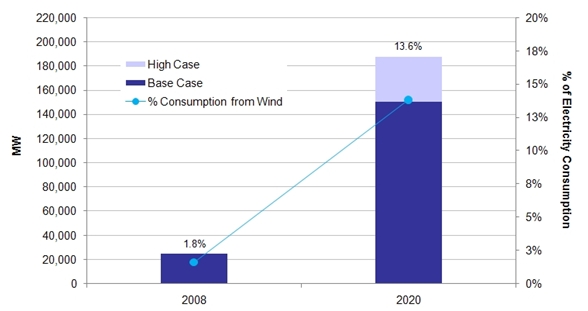
Electric Transmission Investments
Needed to Unlock Enormous Wind Power Resources in
US
Feb 2, 2009 - emerging energy research
Cambridge, Massachusetts - The electric transmission
investments proposed in the new Obama administration’s
stimulus plan would have a major impact on wind power
development in the US, according to Emerging Energy
Research, a Cambridge MA advisory firm in the renewable
energy sector. EER has recently profiled nine of the
largest transmission initiatives under development
in the western United States, which alone are set
to unlock 57 GW of new wind power -- more than tripling
the existing wind power capacity in the US. While
most of these large-scale projects are not scheduled
for completion until after 2015, hundreds of smaller
transmission lines and grid upgrades can provide a
more immediate impact on wind power development in
the US.
The US wind power industry finished 2008 at a record
pace, just ahead of EER’s 2008 base case forecast
of 8,203 MW – the American Wind Energy Association
reports 8,358 MW were installed at year-end. EER expects
a significant decline in 2009 projects due to the
curtailment of project and tax equity financing in
the current economic climate. But according to EER
president William Ambrose, “investments in new transmission
and other renewable policy provisions being considered
in the stimulus bill can go a long way towards maintaining
momentum in the industry.” EER’s high-growth wind
power forecast -- which factors in a national renewable
portfolio standard and stepped up investment in transmission
– estimates 187 GW of wind power capacity by 2020,
accounting for nearly 14% of total US power consumption.
Wind development in the United States remains constrained
by an inadequate and aging transmission infrastructure
that hampers the delivery of wind generated power
from regions of wind-rich resource to population centers
with growing clean energy demands. None of the nine
projects profiled by EER are expected to be fully
operational before 2013, and the timeframe for new
grid capacity is made even more uncertain as these
large projects face complex permitting and siting
hurdles. “Beyond investment, a significant amount
of initiative is required on a Federal level to fast
track permitting and siting of these projects,” says
Ambrose.
With none of the large-scale transmission initiatives
expected to come online between 2008 and 2012, annual
growth in the US wind market may stall at 8-9 GW per
year according to EER. “The inability of transmission
build-out to keep pace with wind project development
activity will increasingly constrain the growth of
the US wind power market in the near-term,” according
to EER senior wind analyst Matthew Kaplan.
The nine projects analyzed by EER will open up large
regions of wind resources stretching from Minnesota
to Southern California. In some regional transmission
areas (RTOs), such as the Midwest Independent Transmission
System Operator and Southwest Power Pool, EER found
that wind projects are the most proposed form of generation,
comprising an average 80% of the total generation
seeking to interconnect. Wind development activity
across the US has prompted some planners to re-shape
transmission projects to include wind: at least four
of transmission projects profiled by EER were initially
targeted for coal generation and have been adapted
to address booming demand for wind power in the western
US.
Exhibit: US Wind Power 2008- 2020, Base Case vs
High Growth (Cumulative MW)
 |
| Source: Emerging
Energy Research |
)
About the Findings
EER’s research findings were released in a Market
Brief, Transmission Initiatives Adapt to Wind US Growth,
part of the company’s North America Wind Advisory
Service, a program that provides on-going analysis
of market trends and developments to wind industry
developers, utilities, and technology suppliers.
EER’s US wind market forecasts appeared in our July
2008 release of US Wind Power Markets and Strategies
2008-2020, an in-depth study providing critical strategic
and tactical support for those seeking to compete
in US wind markets. This 310-page study, produced
annually by EER, features state by state analysis,
market environment rankings, competitive analysis
of utilities, IPPs and developers, as well as US wind
turbine manufacturer and component supplier analysis.
Follow this link for the study's Table of Contents
and Order Information.
About Emerging Energy Research
Emerging Energy Research is a leading industry
advisory firm providing unrivaled balance and perspective
on the world’s clean and renewable energy markets.
Based in Cambridge, MA and Barcelona, Spain, EER works
with more than 1,000 stakeholders across the industry,
providing research-based advice, support, and analysis
to executives and key decision-makers including utilities,
developers, independent power producers, technology
promoters, manufacturers, and investment companies.

|



